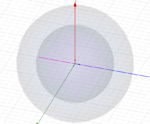isvitri
Newbie level 1
Good morning,
Let me contextualize the problem I found with dissipated power and the way HFSS computes it. I'm working now on a model which goal is to study the power losses that a certain material introduces. To do this, I used a basic electric dipole antenna, at 2.45GHz, which is λ/2 in electrical dimensions. This antenna is placed inside a lossless material sphere and all this is surrounded by another larger sphere made of a material with high permittivity.

The point is that, using exactly the same model in HFSS and in CST, I obtain in CST coherent values with the theory, but HFSS throws much smaller losses and so much higher radiated power than it was supposed to be. The dissipated power in CST is approximately 80% of accepted power and in HFSS less than 30%. Also analyzing E field through the perpendicular direction to the dipole (maximum directive gain in radiation pattern of an electric dipole), the decay is more abrupt in CST (again same as theory) but so smooth in HFSS.
I hope maybe one of you have encountered this tricky thing in HFSS before. Thanks in advance!
Let me contextualize the problem I found with dissipated power and the way HFSS computes it. I'm working now on a model which goal is to study the power losses that a certain material introduces. To do this, I used a basic electric dipole antenna, at 2.45GHz, which is λ/2 in electrical dimensions. This antenna is placed inside a lossless material sphere and all this is surrounded by another larger sphere made of a material with high permittivity.

The point is that, using exactly the same model in HFSS and in CST, I obtain in CST coherent values with the theory, but HFSS throws much smaller losses and so much higher radiated power than it was supposed to be. The dissipated power in CST is approximately 80% of accepted power and in HFSS less than 30%. Also analyzing E field through the perpendicular direction to the dipole (maximum directive gain in radiation pattern of an electric dipole), the decay is more abrupt in CST (again same as theory) but so smooth in HFSS.
I hope maybe one of you have encountered this tricky thing in HFSS before. Thanks in advance!